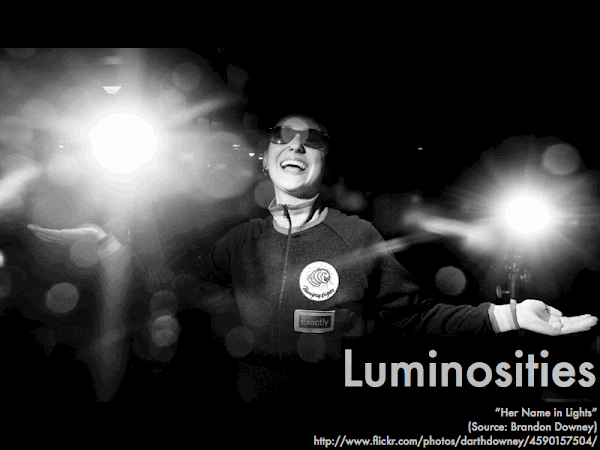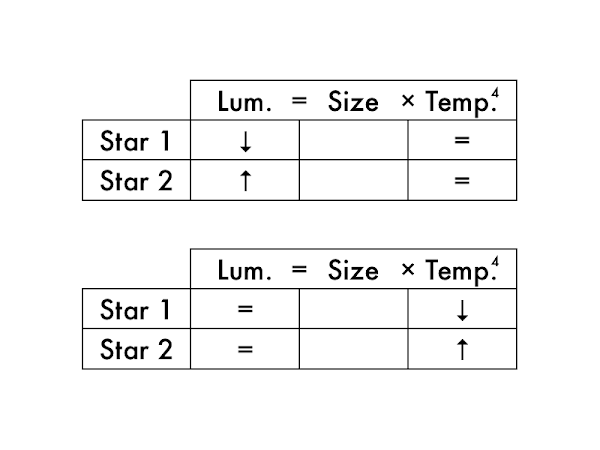Cuesta College, San Luis Obispo, CA
Students have a weekly online reading assignment (hosted by SurveyMonkey.com), where they answer questions based on reading their textbook, material covered in previous lectures, opinion questions, and/or asking (anonymous) questions or making (anonymous) comments. Full credit is given for completing the online reading assignment before next week's lecture, regardless if whether their answers are correct/incorrect. Selected results/questions/comments are addressed by the instructor at the start of the following lecture.
The following questions were asked on reading textbook chapters and previewing presentations on parallax, distance, apparent magnitude, absolute magnitude, Wien's law and the Stefan-Boltzmann law, and a TED-Ed talk on (stellar properties).

Selected/edited responses are given below.
Describe something you found interesting from the assigned textbook reading or presentation preview, and explain why this was personally interesting for you.
"The whole concept of stars that are over a thousand times larger than our sun. It really makes me wonder about our planets relevance to the rest of the infinite universe."
"That we rated stars on their brightness based on what we can see, but not by their actual brightness. I found this interesting because that is the only way the greeks could determine brightness then, but now we have more advanced technology."
"The difference in color and how it correlates to temperature."
"It's crazy to think there's other stars out there brighter than the sun, but because it's so far away we can't tell just by looking."
"The magnitude scale where the brightest star is negative and the bigger the number (when positive) are dimmer stars."
"I find it interesting that a blue star is hotter than a red star because I always think of hot things as more red and cold things as blue."
"The distance of a star can be measured using parallax."
"How parallax can be used to measure distance. I never really thought about how parallax changes with distance."
"Learning that the size of a parallax corresponds to how far away a star is depending on the amount of shift."
"The effects of star sizes on the widths of spectral lines--I thought it was interesting to see the differences between giant, super-giant and main-sequence stars."
"I knew stars were far away but not as far as they actually are. I think it is crazy we are able to measure stuff that is so far away."
"Using the rainbow spectrum to see what a star is made of. This was interesting because it sounds difficult to uncover what is in a star, but its quite simple."
Describe something you found confusing from the assigned textbook reading or presentation preview, and explain why this was personally confusing for you.
"Why did we choose to use the 10 parsecs or 32.6 light-years? it seems like a random number to use. I think remembering the difference between apparent and abslute magnitude will be a tad tricky. But I'm fairly certain I can grasp it."
"Figuring out which stars are brighter/dimmer or hotter/cooler when comparing the two stars' luminosity/size/temperatures."
"I'm still not 100% on the luminosity,size, and temperature of a star. The correlation between them gets confusing."
"I was a little confused when ranking the temperatures of supergiant and dwarf stars because I didn't know if a white dwarf would be hotter than a yellow supergiant if the supergiant is larger."
"I am still confused about what the size and luminosity have to do with each other."
"I didn't find anything to be particularly confusing. Some of the graphs/images in the textbook took a bit of time to interpret, but was made understandable after reading through the material/looking at the presentations."
Explain how apparent magnitude and the absolute magnitude are defined differently.
"The apparent magnitude is the magnitude the star has where it currently exists. The absolute magnitude is the magnitude the star would have if it were 10 pc away."
"Apparent magnitude is the brightness of a star that we see here on Earth, not taking into consideration the distance to it. Absolute magnitude is the brightness a star would have if it were 10 pc away from Earth, so the actual brightness of a star."
"Apparent magnitude is when a stars brightness is measured by brightness without compensating for distance. Absolute magnitude is when a stars brightness is measured taking into account the star's distance."
Suppose the sun was moved to a distance of 10 parsecs away. As a result, its __________ magnitude would become dimmer.
absolute. ********** [10] apparent. ***************** [17] (Both of the above choices.) [0] (Neither of the above choices.) [0] (Unsure/guessing/lost/help!) **** [4]

(Only correct responses shown.)
1 (brightest): the sun, m = –27 [87%]
2: Canopus, m = –1 [84%]
3: Vega, m = 0 [84%]
4 (dimmest): Kapteyn's star, m = +9 [87%]
Rank the brightnesses of these stars (1 = brightest, 4 = dimmest; there are no ties), if relocated to 10 parsecs from Earth.
(Only correct responses shown.)
1 (brightest): Canopus, M = –3 [77%]
2: Vega, M = +0.5 [80%]
3: the sun, M = +5 [77%]
4 (dimmest): Kapteyn's star, M = +11 [87%]
Determine whether these stars get dimmer or brighter when relocated from their original positions to 10 parsecs from Earth.
(Only correct responses shown.)
The sun: gets dimmer [87%]
Canopus: gets brighter [74%]
Vega: gets dimmer [64%]
Kapteyn's star: gets dimmer [68%]
Rank the temperatures of these main sequence stars (1 = hottest, 4 = coolest; there are no ties).
(Only correct responses shown.)
Hottest: blue main sequence star [84%]
Second hottest: white main sequence star [71%]
Third hottest: yellow main sequence star [81%]
Coolest: red main sequence star [90%]
Rank the temperatures of these supergiant and dwarf stars (1 = hottest, 4 = coolest; there are no ties).
(Only correct responses shown.)
Hottest: blue supergiant [77%]
Second hottest: white dwarf [61%]
Third hottest: yellow supergiant [74%]
Coolest: red dwarf [90%]

dimmer. ***** [5] brighter. *********************** [23] (These stars would be the same size.) [0] (Unsure/guessing/lost/help!) *** [3]
Two stars (equally far away) have the same brightness, but one star is cooler, and the other star is hotter. The __________ star will be larger in size.
cooler. ***************** [17] hotter. ********** [10] (These stars would be the same size.) [0] (Unsure/guessing/lost/help!) **** [4]
Ask the instructor an anonymous question, or make a comment. Selected questions/comments may be discussed in class.
"Can you go over the answers for the ranking of the temperatures for supergiant and dwarf stars?"
"Can you explain the Stefan-Boltzmann law more?"
"Sorry, been a very busy and stressful week for me and have not had a chance to read the section."
"Besides finding out the basics like temperature, size, and color of the star what else can we deduce from observing the stars?" (Their ages, how they were born, and how they will die.)
"I find this stuff interesting, but sometimes find application to daily life to be lacking. Any thoughts?" (After we learn about how stars are born, live, and die, we'll see what clues they tell us about how the atoms that make up everything we know were made. #ponderthis #deepthoughts #thingsthatmakeyougohmmm.)
"How many more extra credit opportunities will there be?" (A few more.)
"Star Wars or Star Trek?" (***Does Jedi hand-wave*** This is not the answer you're looking for. But then again, there is an "epic supercut" that may or may not answer your question.)
No comments:
Post a Comment